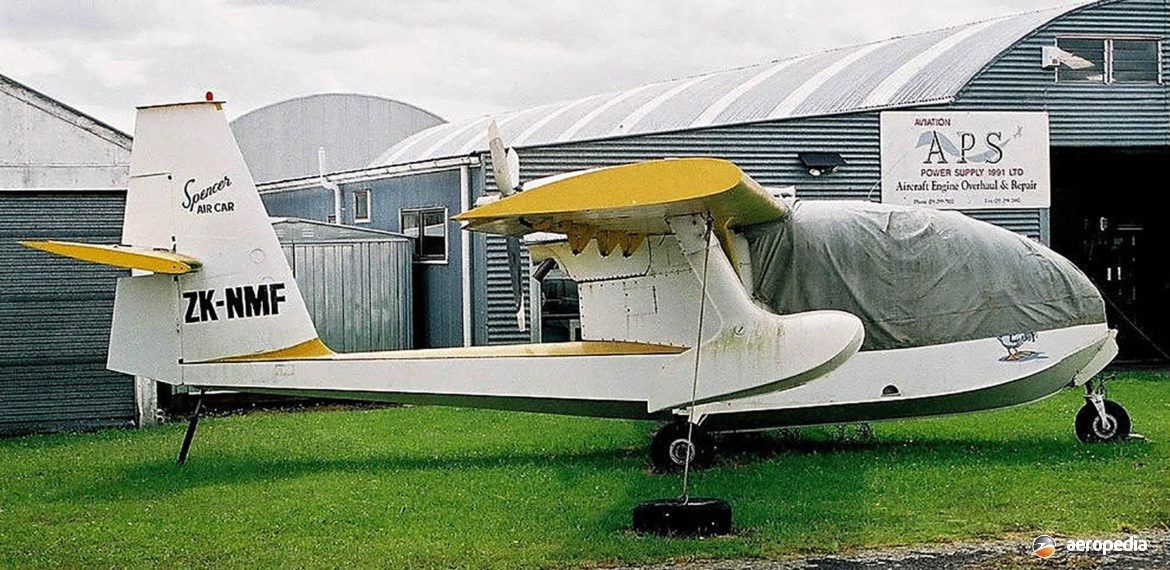Photograph:
Spencer S-12E Air Car ZK-NMF (c/n AACA-319) at Ardmore, NZ in 2006 (NZCIVAIR)
Country of origin:
United States of America
Description:
Four-seat amphibious flying-boat
Power Plant:
One 213 kw (285 hp) Teledyne Continental Tiara 6-285-B six-cylinder horizontally-opposed air-cooled engine
Specifications:
- Wingspan: 11.38 m (37 ft 4 in)
- Length: 8.05 m (26 ft 5 in)
- Height: 2.9 m (9 ft 6 in)
- Wing area: 17.1 m² (184 sq ft)
- Max speed at sea level: 237 km/h (147 mph)
- Max cruising speed at 1,675 m (5,500 ft): 225 km/h (140 mph)
- Max rate of climb at sea level: 305 m/min (1,000 ft/min)
- Stalling speed: 69 km/h (43 mph)
- Range cruising at 65% power at 2,375 m (7,800 ft) with 20 mins reserve: 1,285 km (800 miles)
- Empty weight: 993 kg (2,190 lb)
- Loaded weight: 1,451 kg (3,200 lb)
History:
The Spencer Air Car, also known as the Amphibian Air Car, was designed by Mr P H Spencer as a four-seat amphibian bearing a strong resemblance to the Republic Seabee, which he also designed. Mr Spencer originally built a two-seat amphibian in the 1950s fitted with an 82 kw (110 hp) engine. This was eventually developed into a four-seat version called the Model S-12-C. Subsequently, plans were made available to amateur builders of a refined model known as the S-12-D, and the model S-12-E was later released.
The prototype S-12 made its first flight at Chino in California in May 1970, and the first amateur constructed example was completed and flown in September 1974. A number of sets of plans have been sold around the world and about 50 are known to have been completed. Power plants ranging from 149 kw (200 hp) to 213 kw (285 hp) could be installed.
Seating was for four in a roomy cabin, the rear seats being able to fold against the bulkhead to provide cargo or baggage space in the rear fuselage. Dual controls were standard. Construction was a wing of braced wood, steel and fibreglass. The stabilising floats were of fibreglass; and the hull was of wooden frames, longerons and skin. The cabane structure was of welded steel tube, this providing wing and engine mountings and attachment points for the retractable undercarriage. The S-12-D was fitted with either the Lycoming O-320 or O-540 engine, whereas the S-12-E used the Continental Tiara engine which provided 213 kw (285 hp). However, this engine was not a success commercially and only a few had this engine installed.
A Model S-12-E (c/n AACA/319) was registered in New Zealand as ZK-NMF (c/n AACA/319). This aircraft was built by Neil Falconer of Gore over a lengthy period from 1972 and was first registered on 18 August 1987. Special dispensation was obtained from the New Zealand DCA as it was a larger aircraft than normally built as a homebuilt. However, the builder passed away and the aircraft was only thereafter occasionally flown by his son. In 1991 the aircraft was withdrawn from service and placed in storage. In July 1997 it was purchased by a group known as the NMF Syndicate at Kumeu and was subsequently flown by a member of the syndicate. In April 2001 ownership was transferred to SAC Holdings of Auckland and it was based at Ardmore until 7 April 2011 when its registration was revoked.
Construction of a further example, a Model S-12-E, commenced in Australia, this aircraft being registered VH-IRG3 (c/n E397) on 18 May 2003 to Ian Goldie of Port Macquarie, NSW, powered by a Teledyne Continental IO-520 engine. At that time it had not been finished. However, as far as is known, as at late 2020, the aircraft still had not been completed. However, an example of the S-12E was completed as VH-ONE8 (c/n 351 – ex N351DP) to Fly and Boats Pty Ltd of Port Melbourne on 30 September 2020.

